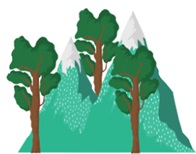Meaning of Weather and Climate
1) What Is Meteorology?
The branch of science which deals with weather forecasting and studies the changes in the elements of weather and climate is called meteorology.
2) Why Do Places Lying in the Mountains Receive More Rainfall?
- The mountains are located at a great height from sea level.
- The wind which blows towards land from the sea carries moisture with it.
- Such a wind rises when a mountain lies in its path as a barrier.
- As the wind rises, it cools down, leading to rainfall or precipitation.

3) Why Do We See the Tops of the Mountains Covered With Snow Almost Throughout the Year?
- The tops of the mountains are at a great height from sea level.
- The temperature keeps on decreasing as we go up from the sea level.
- Due to extremely low temperatures, precipitation occurs in the form of snowfall and covers the mountain tops with snow.
- As the wind rises, it cools down, leading to rainfall or precipitation.

4) The Temperature Falls As We Move Up the Mountains. Why Do You Think It Happens?
- The air around us not only provides life-supporting gases to breathe but also absorbs heat from the surroundings and maintains an optimum temperature.
- As we climb the mountains, the air becomes thinner and is not able to retain more heat. Hence, there is a considerable fall in the temperature.
5) Why Do Places Near Seas and Oceans Have Moderate Climates Throughout the Year?
- The places near seas and oceans have moderate climates throughout the year because of the presence of large water bodies.
- Water has a high heat capacity. The time required for heating of water body is nearly five times as compared to land.
- Similarly, when the temperature falls, the heat given out by a water body is nearly five times that of the heat given out by land.
- Such a phenomenon helps in maintaining an optimum temperature in the places around water bodies. It neither gets too hot nor too cold.
6) During Which Time or Phase Are the Minimum and Maximum Temperatures in a Day Experienced?
The maximum temperature in a day occurs in the afternoon and the minimum in the early morning.
Share

